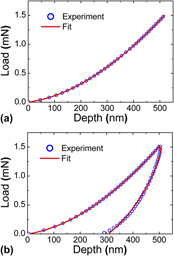Article contents
Determination of shear creep compliance of linear viscoelastic solids by instrumented indentation when the contact area has a single maximum
Published online by Cambridge University Press: 09 May 2012
Abstract

Lee and Radok [J. Appl. Mech.27, 438 (1960)] derived the solution for the indentation of a smooth rigid indenter on a linear viscoelastic half-space. They had pointed out that their solution was valid only for regimes where contact area did not decrease with time. In this article, a large number of finite element simulations and one typical experiment demonstrate that Lee-Radok solution is approximately valid for the case of reducing contact area. Based on this finding, three semiempirical methods, i.e., Step-Ramp method, Ramp-Ramp method and Sine-Sine method, are proposed for determination of shear creep compliance using the data of both loading and unloading segments. The reliability of these methods is acceptable within certain tolerance.
Information
- Type
- Articles
- Information
- Copyright
- Copyright © Materials Research Society 2012
References
REFERENCES
- 8
- Cited by

